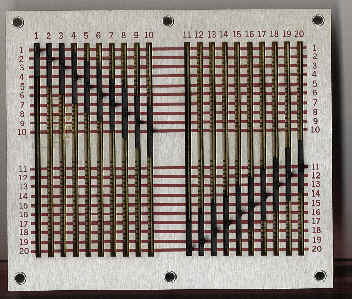The Arp 2500 |
|
The three main manufacturers of 'big synthesizers' in the early years, Moog, ARP and EMS each developed their own solutions to the problem of interconnecting signals. In the case of ARP, they favored the use of slide switches over the Moog tradition of a tangle of patch cords... |
|
| A Cherry C10-02A Switch assembly of similar type to that used by ARP (manf. 1973) | |
| The input and output graphics are sited at the top and bottom of each module, these coincide with the pitch of the sliders of the matrix switches. Each module has a maximum of 20 connections, 10 at the top and 10 at the bottom. Individual sliders can select one of 20 rows, allowing signals to be 'bussed' along the top and bottom banks. The switches have a 'Dead' area of three detents between rows 10 and 11. (ARP rather misleadingly describe modules as having 40 outputs, they however do have access to 40 busslines) Bussline signals could be accessed via jack sockets at the center and either ends of the upper and lower switch banks . | |

